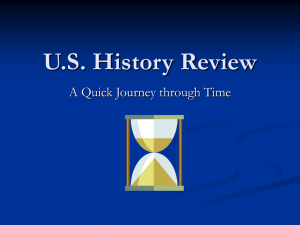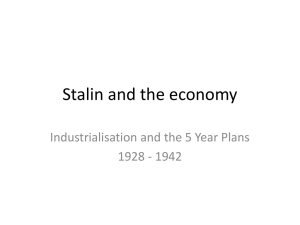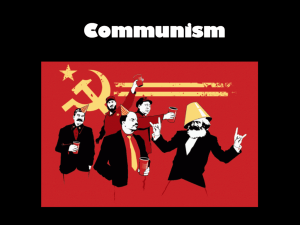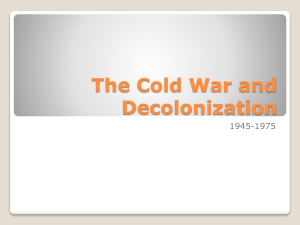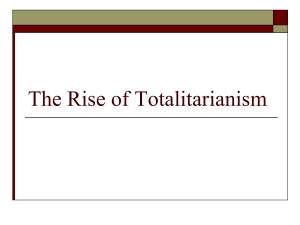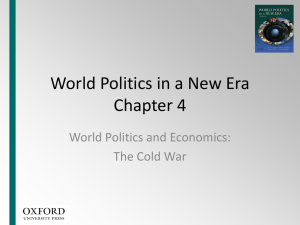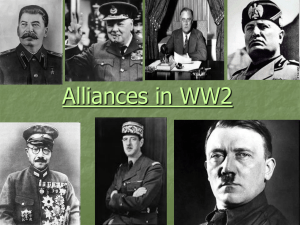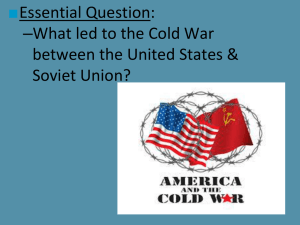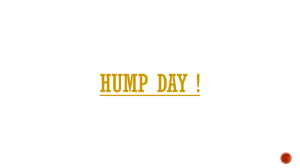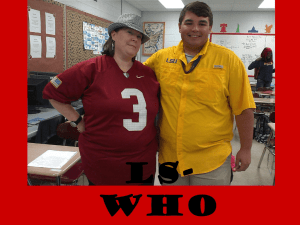Cold War_1
advertisement
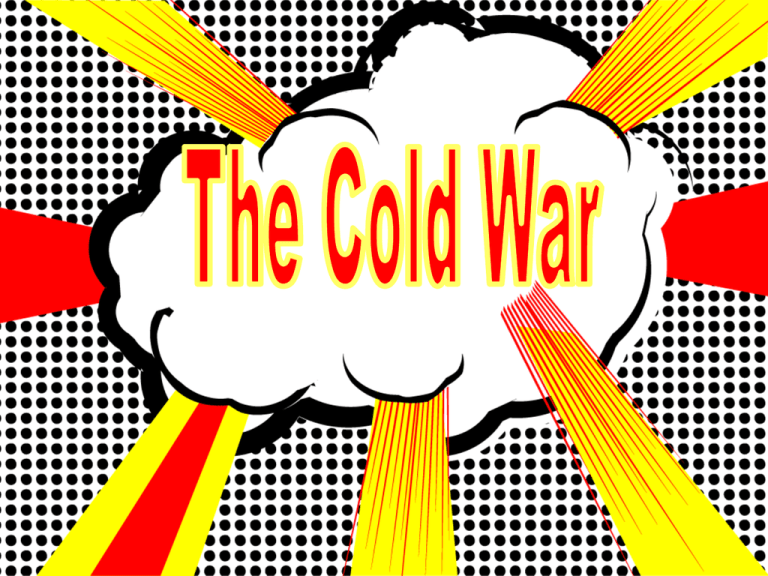
USA Cold War USSR YouTube 1. http://www.youtube.com/watch?v=jRA4QFHZBA Cold War Background: • A bipolar conflict involving two great blocs that appeared to “superimpose” their rivalry on the rest of the world • It was a struggle carried on by all means short of war: – Massive arms build-up and nuclear weapons to make both sides virtually impregnable – Diplomacy being turned into a kind of “militarised thinking” that concentrated on building and strengthening alliances Cold War Background: • Each side denying the other’s right to exist: – USSR being convinced that Capitalism and Communism could not co-exist as Capitalism was immoral and doomed to collapse – USA seeing the USSR as an “evil empire” Cold War Background: • Each side conducted ferocious attacks against the other and suppressed internal dissidence: – Stalin’s paranoid reaction to opposition – Milder form of repression in the West, e.g. McCarthyism (Commission to review the loyalty of American Civil Servants and to weed out Soviet agents and sympathisers) Cold War Main Issues • PIES – Power (A race for hegemony [dominance] resulting in superior power to influence others) – Ideology (Western Capitalist Democracy vs Communist Authoritarianism) – Economics (Control of markets / resources / trade) – Security (Political / Economic / Territorial / Imagined vs Real) Cold War Why did the Cold War break out? • Competing Ideologies • Feelings of Mistrust • Wartime Alliances Broke Down Cold War Why did the Cold War break out? • Competing Ideologies – The Cold War confrontation between the USA and the USSR was a clash between their opposing ideologies: Capitalism (USA) and Communism (USSR) Cold War Why did the Cold War break out? • Competing Ideologies – Both sides felt that their ideologies were the best for the rest of the world to follow – Supporters of Democracy felt that a choice between Capitalism and Communism meant choosing freedom or slavery – Supporters of Communism felt that workers were not free in Democratic societies and were slaves of the rich landowners, factory owners and powerful industrialists Cold War Why did the Cold War break out? • Competing Ideologies – As each side felt their own ideologies were the best to be followed, there was competition amongst them to prove otherwise Cold War Why did the Cold War break out? • Feelings of Mistrust – Mistrust of Communists by the USA and the West began in 1917 when Communism became first established in Russia following the October 1917 Revolution – The Russians had proclaimed a “World Revolution” – The USA was afraid that a worldwide Communist revolution would mean the end of Capitalism and Democracy Cold War Why did the Cold War break out? • Feelings of Mistrust – The West had also become involved in the Russian Civil War against the Communists (The Communists were known as the Reds, the Western troops, the Whites) – The West (Britain, France, Japan and the USA) sent funds and troops to prevent the spread of Communism – The West also provided aid to anti-Bolshevik White Armies Cold War Why did the Cold War break out? • Feelings of Mistrust – In short, mistrust had always occurred between the West and the Communists – Now that the USA and the USSR were the two new post-WW2 Superpowers, they had the power to spread their influence worldwide, making the Cold War more possible Cold War Why did the Cold War break out? • Wartime Alliances Broke Down – During WW2, the USSR joined the Allies to defeat Germany, a common enemy – Once the war was over, the two countries (USA and USSR), returned to their old relationship of mistrust and suspicion – The wartime alliances also broke down after a series of conferences to decide on the fate of Germany – Another cause for the alliances to break down was Soviet policy regarding Eastern Europe Cold War Why did the Cold War break out? • Wartime Alliances Broke Down – While the USA planned for free elections and western style democracies in Eastern Europe, the USSR wanted to create a zone of friendly communist governments in the area – Moreover, at the end of WW2, the Soviet Red Army, on the pretext of chasing out the Nazis, stepped in to occupy these territories Cold War How was Europe affected? • Europe was divided: – Between 1945 and 1948, Europe was divided into 2 sides – the Eastern European Communist countries and in the Western European Democratic countries Cold War How was Europe affected? • Europe was divided: – The USSR expanded its control over the Eastern European countries by occupying them with Soviet troops so that the USSR could not be attacked through these countries. Stalin also set up Communist governments in these countries so that he could influence them to follow proUSSR policies. These countries were known as satellite states Cold War How was Europe affected? • Europe was divided: – The West viewed this policy as hostile and aggressive and criticised the USSR for not holding democratic elections and oppressing democracy in the satellite states – Churchill described Europe as being divided into two spheres of influence by an “Iron Curtain” (an imaginary line between the Soviet satellite states in the East and the Democratic states in the West Cold War The Truman Doctrine (1947): • In order to prevent Communism from spreading, President Truman announced the plans for the Truman Doctrine. According to the doctrine, the USA would help other democratic countries when they were threatened by Communism • The Truman Doctrine (or Containment Policy) was to force Communism to remain within its borders by giving money, weapons, fuel and other incentives to countries in danger of being taken over by Communists Cold War Marshall Plan (1947): • The Marshall Plan offered financial help to Europe to help it recover from World War II and to build a prosperous and successful Western Europe which would resist Communism by giving loans, aid and goods • The USA believed that with the Marshall Plan, the people of Western Europe would be more prosperous and less likely to support Communism • Stalin forbade the Soviet satellites to accept the Marshall Plan Cold War Marshall Plan (1947): • As a result of the Marshall Plan, Western Europe recovered faster from the effects of WW2 than Eastern Europe. The Marshall Plan also heightened Cold War tensions as the USSR saw the Marshall Plan as an attempt to spread Democracy and Capitalism through the use of money • The USSR set up COMECON (Council for Mutual Economic Co-operation) in response to the Marshall Plan and to encourage trade and co-ordinate the economic policies among the Communist countries Cold War How was Europe affected? • Germany was divided: –Conflicts on how to administer Germany led to a crisis among Britain, France, the USA and the USSR in 1948 Cold War How was Europe affected? • Germany was divided: – Despite making agreements at Yalta and Potsdam, in 1948, Britain, France and the USA joined their separate zones in Germany and created a new currency for their sphere of influence. This action helped West Germany recover faster from the damage caused by WW2. The West also had democratic elections for West Germany. However, East Germany did not have all this as it was under a Communist party under Soviet control Cold War How was Europe affected? • Germany was divided: – Seeing the progress made by West Germany, Stalin was afraid that Germany would grow strong again and be a threat to the USSR. He planned to seize control of West Berlin by blocking all road, rail and canal links between West and East Germany in 1948. The crisis became known as the Berlin Blockade. Stalin believed that he could force the British, French and Americans to leave the city by blocking all supplies of food to West Berlin Cold War How was Europe affected? • Germany was divided: • For the USA, it was important to support West Berlin because it represented the democratic system. The USA was also concerned that if it pulled out of West Berlin, the Soviets may have invaded West Germany • Knowing that retaliation by troops would result in a full-scale war, Harry Truman (President of the USA) deployed a fleet of planes to fly over the blockade and bring food and supplies to the West Berliners. The USSR could not do anything about the planes as shooting them down would be a declaration of war • After 10 months, the USSR realised that it had not succeeded and ended the blockade in 1949. Following the blockade, Germany was separated into two countries – West Germany and East Germany Cold War How was Europe affected? • Germany was divided: • For the USA, it was important to support West Berlin because it represented the democratic system. The USA was also concerned that if it pulled out of West Berlin, the Soviets may have invaded West Germany • Knowing that retaliation by troops would result in a full-scale war, Harry Truman (President of the USA) deployed a fleet of planes to fly over the blockade and bring food and supplies to the West Berliners. The USSR could not do anything about the planes as shooting them down would be a declaration of war • After 10 months, the USSR realised that it had not succeeded and ended the blockade in 1949. Following the blockade, Germany was separated into two countries – West Germany and East Germany Cold War • NATO (1949) and Warsaw Pact (1955) were set up: – The division of Europe into two spheres of influence and forced the USSR and the USA to seek allies through military alliances – The USA built up their forces in Europe through NATO (North Atlantic Treaty Organisation) in 1949 to defend Europe from Soviet attack – The USSR and all the Communist countries of Eastern Europe joined the Warsaw Pact in 1955 Cold War How did the Cold War affect the rest of the world? • China joined the Cold War: • Having defeated the Nationalists, the Chinese Communist Party took control of China and proclaimed the creation of the Peoples’ Republic of China in October 1949 • The USA then saw the Communist alliance between the USSR and China as a single, united enemy determined to control the world • The USA was also afraid that the USSR would give China nuclear weapon technology as the USSR had recently tested its own nuclear weapons Cold War How did the Cold War affect the rest of the world? • Japan became the USA’s main-Communist ally: • Faced with the threat of Communism, the USA strengthened Japan’s economy and introduced democratic reforms in order to turn Japan into its main ally in the region. It also provided Japan with economic aid, new technology, new industrial equipment and lifted trade restrictions on the country. It also supported Japan’s entry into several world bodies (IMF, UN, World Bank) • The USA and Japan also signed the 1952 US-Japan Mutual Security Treaty where the USA promised to come to Japan’s aid if Japan was attacked. The treaty also allowed the USA to station troops in Japan Cold War How did the Cold War affect the rest of the world? • USA’s One China Policy: • Due to their unfriendly relations, the USA adopted a One China Policy from 1945 to 1972 and refused to recognise the Peoples’ Republic of China (PRC). Instead, it recognised Taiwan (Republic of China – ROC) as the legitimate government of China Cold War How did the Cold War affect the rest of the world? • Increased US Support for anti-Communists in Asia: • Communism in China also led the USA to search for other allies in Asia. In addition to forming alliances with Taiwan, the USA also sent troops to support anti-Communist governments in South Korea (1950) and South Vietnam (after 1954) • An anti-Communist alliance to oppose Communist gains in Southeast Asian was formed. It was called the Southeast Asian Treaty Organisation (SEATO) • The USA also competed with the USSR in search for allies in the Middle East (Israel and other Arab States) and in Africa (Congo, Angola, etc)
